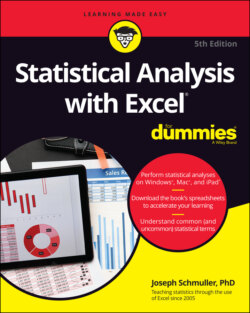Читать книгу Statistical Analysis with Excel For Dummies - Joseph Schmuller - Страница 14
Variables: Dependent and independent
ОглавлениеSimply put, a variable is something that can take on more than one value. (Something that can have only one value is called a constant.) Some variables you might be familiar with are today’s temperature, the Dow Jones Industrial Average, your age, and the value of the dollar against the euro.
Statisticians care about two kinds of variables: independent and dependent. Each kind of variable crops up in any study or experiment, and statisticians assess the relationship between them.
Imagine a new way of teaching reading that’s intended to increase the reading speed of fifth-graders. Before putting this new method into schools, it’s a good idea to test it. To do that, a researcher randomly assigns a sample of fifth-grade students to one of two groups: One group receives instruction via the new method, and the other receives instruction via traditional methods. Before and after both groups receive instruction, the researcher measures the reading speeds of all the children in this study. What happens next? I get to that in the upcoming section “Inferential Statistics: Testing Hypotheses.”
For now, understand that the independent variable here is the method of instruction. The two possible values of this variable are new and traditional. The dependent variable is the improvement in reading speed (a child’s speed after instruction minus that child’s speed before instruction) — which you would measure in words per minute.
In general, the idea is to find out if changes in the independent variable are associated with changes in the dependent variable.
In the examples that appear throughout the book, I show you how to use Excel to calculate characteristics of groups of scores. Keep in mind that each time I show you a group of scores, I'm really talking about the values of a dependent variable.
